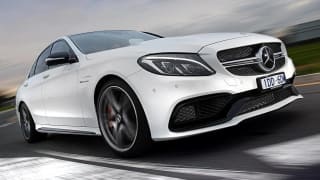
Mercedes-Benz C63 AMG S 2015 review
Craig Duff road tests and reviews the new Mercedes-Benz C63 AMG S, with specs, fuel consumption and verdict at its Australian launch.
Browse over 9,000 car reviews
Gosh, where do you start with Alfa Romeo? How do you rake over the last three decades of promise, glimpses of brilliance and then, ultimately, disappointment? All those false dawns, all those announcements, scrappings, re-announcements. It's a car brand with die-hard fans that have gotten used to disappointment, like followers of St Kilda.
The last few years have been particularly fraught. Down to just the Giulietta (a pretty thing but outclassed and over-priced), and the MiTo (yeah, I know), the mad 4C popped up to remind us that Turin could occasionally kick out a sports car, even if it was a bit lively for some.
Add to that, the Giulia. This car has had possibly the longest and weirdest journey to production. It was supposed to replace the beautiful but underwhelming 159, it started out as front-wheel drive, survived two (or was it three?) strategy changes, and then finally, everything was settled.
Alfa stole some Ferrari engineers, wrote a cheque for five billion dollars and - finally - got on with it. The fruit of all that is the Giulia. The sweetest fruit is the Giulia Quadrifoglio.
| Alfa Romeo Giulia 2017: Quadrifoglio (qv) | |
|---|---|
| Safety rating | |
| Engine Type | 2.9L |
| Fuel Type | Premium Unleaded Petrol |
| Fuel Efficiency | 8.2L/100km |
| Seating | 4 seats |
| Price from | $77,110 |
The Giulia itself isn't as good-looking as the car it replaces, but has enough Alfa emotion to please the fans. Once the Quadrifoglio treatment has been added, though, it toughens up, drops to the weeds and looks properly purposeful.
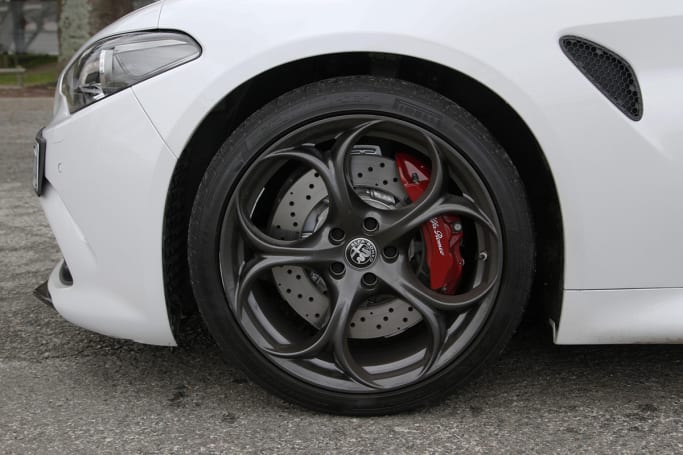
The 19-inch wheels look like 20s in the arches and the whole car is tightly drawn down over the rubber. Even in white, it looks dramatic and ready to brawl.
Inside is... well, for an Alfa, it's a revelation. While not at Audi level, the cabin is a big cut above what we're used to, with a solid feel, sensible design (while not forgetting the hooded instruments). It looks like it was all designed together and is free of frippery and pointless decoration.
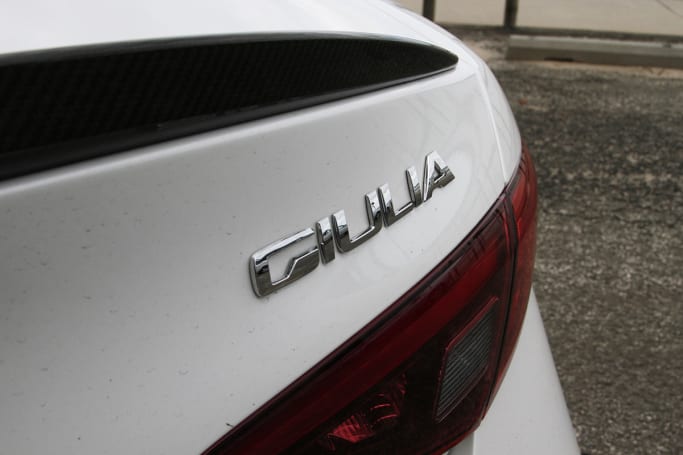
The carbon inlays caused a few arguments as to their carbon-fibrey-ness, but overall it's well executed, looks great and feels good. Space is good for all four occupants (we'll get to that), nothing feels dodgy or flimsy - think somewhere between the beautifully wrought Mazda CX-9 interior and an Audi A4. Somewhere in there. The only let down is the shifter, which feels a bit cheap.

The Giulia is normally a five-seater with a back seat that folds down, but there's none of that nonsense here. The Quadrifoglio has just four seats, two cupholders up front, bottle holders (small) in the doors and a decent-sized console bin.
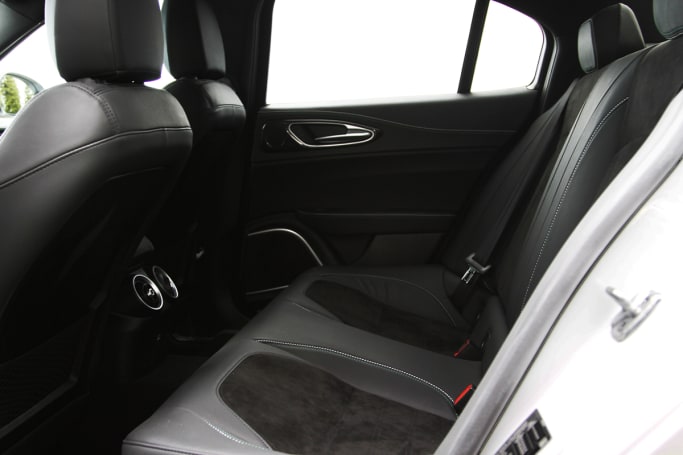
You sit low in the front seats, which have heaps of adjustment, a three position memory and they're properly comfortable - firm, supportive, grabby when you need it.
Rear seat passengers have plenty of room, too, with space enough for my six-foot-one teenager in the back, with room to spare behind my shorter frame's driving position.
Boot space matches all three German rivals litre-for-litre at 480.
The Giulia Quadrifoglio kicks off at a slightly eye-watering $143,900, just a few hundred bucks shy of BMW's M3 Competition.
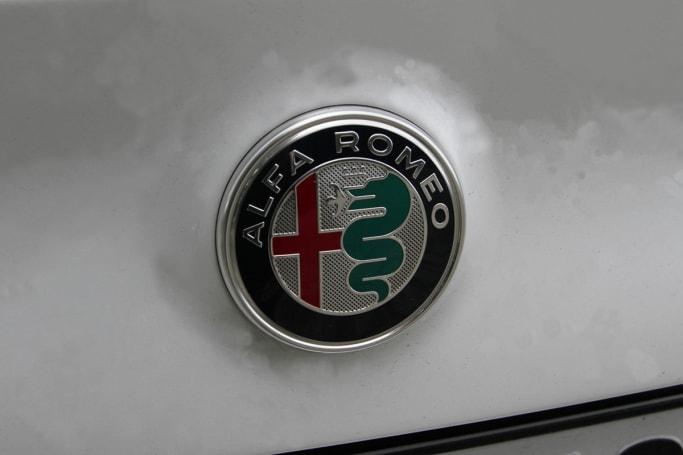
You start with a 14-speaker stereo, 19-inch alloys, dual zone climate control, keyless entry and start, front and rear parking sensors, active cruise control, active bi-xenon headlights, electric heated front seats, sat nav, leather and Alcantara trim, auto wipers and headlights and a pretty decent safety package.
You can have red or pay anywhere from $1690 to $4550 for paint. The 'Trofeo White' paint job on the test car was spectacular - three coats for that latter $4550.
On top of all that, you can spec up with different wheel designs ($650), different coloured calipers ($910), carbon and Alcantara steering wheel ($650), carbon-fibre front seats from Sparco ($7150) and carbon ceramic brakes ($13,000, which actually isn't bad)
Heart and soul of the Giulia is the 2.9-litre twin-turbo 90-degree petrol V6 which generates a staggering 379kW and 600Nm. Power goes to the rear wheels via ZF's excellent eight-speed automatic (I wonder how many 'TCT' gearboxes were blown during development? Or if they even tried?) and slings the Giulia from 0-100km/h in 3.9 seconds. It's quicker than an M3 and it should be given it's got more power and more gears.
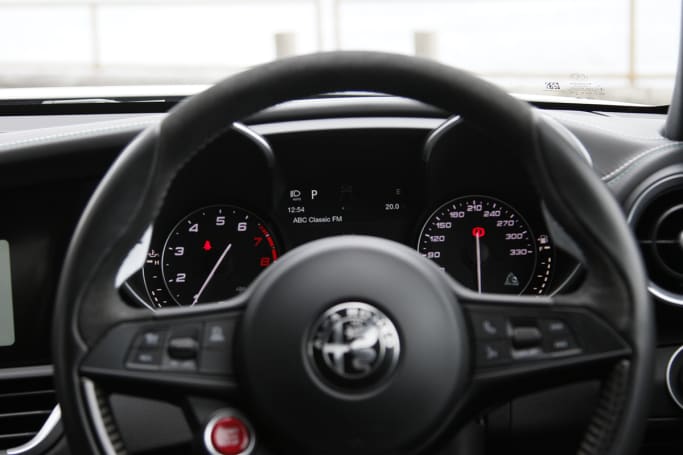
The V6 shares the same bore and stroke as the Ferrari California's V8 but otherwise, we couldn't possibly comment on the relationship.
The government testing regime yielded an official figure of 8.2L/100km. When driven as intended, it is extraordinarily unlikely you will get anywhere near that number. However, if you're careful, there's no reason you can keep it under 10.0L/100km. But you wouldn't, would you?
There's so much Ferrari in this car, which is no surprise given who put it together. Roberto Fedeli led the team and he was one of the high-profile Ferrari engineers to come across. He may have had something to do with the 458 and California...
Start the car with the big red button in the steering wheel and the engine fires without fanfare (unless you've left it in Dynamic). The DNA drive mode dial lets you choose a suspension and throttle tune between hard and harder, while in A (Advanced Efficiency) you can pootle along in traffic and enjoy the savings offered by cylinder deactivation and a very soft throttle pedal.
Yeah, right.
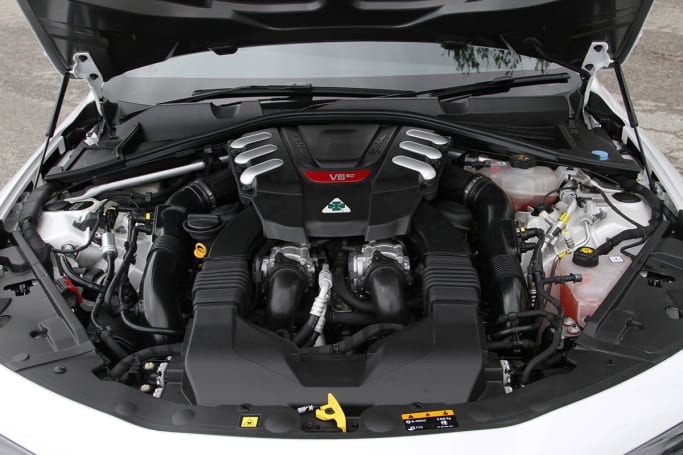
I can't believe anyone who buys this car would ever use A, but hey, you know it's not terrible if you're considering it. In fact, when you're out on the freeway, it's perfect - smooth, quiet and as soon as you sink the slipper, everything switches back on and you're jumping to warp nine with little hesitation.
The kerb weight of the Giulia Q is under 1600kg. While that's not Lotus light, it's still an impressive mark given smaller cars with less to offer can't squeeze under 1600kg and a couple of its rivals are 200kg heavier.
Partially responsible for this achievement is the liberal use of carbon-fibre - the whole bonnet is made of the stuff, as is the roof - while the guards and doors are aluminium. Pop the bonnet on the Alfa and you won't believe how light it is, the lovely carbon weave left unpainted on the underside. You can even see a sliver of composite on the underside of the bonnet from the driver's seat. That's neat.
There's another mode, too. Race. You have to push the DNA dial anti-clockwise and through a detente. While DNA comes up red on the big screen, this goes orange. I know why - the electro-nannies are packed off on holiday and the car turns into a complete hooligan.
Pop the bonnet on the Alfa and you won't believe how light it is, the lovely carbon weave left unpainted on the underside.
The turbos spin harder for more torque, and the transmission turns into a deadly weapon, just shoving the gears home with vivid enthusiasm. The paddles elicit a response only shamed by the throttle's. It's a complete animal. The exhaust roars, the chassis tenses up and the steering, oh, the steering.
Down a set of twisting roads you won't believe how addictive and fun this car is, while also demanding you show it a bit of respect. The torque vectoring rear diff will let you kick the tail out on the track and will threaten it on the road if you go silly with the throttle.
The crack on the upshift is more than reminiscent of the California's - this car does theatre better (in ascending order) than the BMW M3, Audi RS4 or Mercedes C63, and those three give it a red hot go.
The good thing is, though, that this car is good in D, N, A and R. It will never be the world's most comfortable car, but it comes mighty close to being the most comfortable sporting sedan.
It's a revelation, this Giulia.
Basic Warranty
3 years / 150,000 km warranty
ANCAP Safety Rating

The five star ANCAP safety package consists of six airbags, ABS, stability and traction controls, reversing camera, forward collision warning, forward auto emergency braking (high and low speed), lane departure warning and reverse cross traffic alert.
The forward collision warning is hands down the most entertaining audio alert since the horn on a 1970s-era Renault 12.
Alfa Romeo offers a three year/150,000km warranty with roadside assist for the same period.
Servicing is every 12 months/15,000km and you can pre-pay three years of servicing at purchase time.
The Alfa scores highly not just because the engine is great but because the whole package is a belter. On the track, CarsGuide's Tim Robson hooted with joy, on the road Richard Berry rubbed his hands with glee. I could not get the stupid grin off my face.
It takes a lot to knock a car from its top-of-the-tree perch but the Alfa may just have deposed the BMW M3 from my mid-size go-to quick car. It might even just shade BMW's M2.
This isn't anything like even Alfa's glory days, this is something really special. This is a car that will beguile you from the second you first plonk yourself into the Alcantara seat down to the last tick from the cooling engine after a hard run through the hills.
This isn't just one for the fans. This Alfa is going to change a lot of minds.
| Vehicle | Specs | Price* | |
|---|---|---|---|
| (base) | 2.0L, PULP, 8 SP AUTO | $29,480 – 35,530 | 2017 Alfa Romeo Giulia 2017 (base) Pricing and Specs |
| Super Diesel | 2.1L, Diesel, 8 SP AUTO | $26,510 – 32,670 | 2017 Alfa Romeo Giulia 2017 Super Diesel Pricing and Specs |
| Super Petrol | 2.0L, PULP, 8 SP AUTO | $31,680 – 38,170 | 2017 Alfa Romeo Giulia 2017 Super Petrol Pricing and Specs |
| Veloce | 2.0L, PULP, 8 SP AUTO | $37,730 – 44,330 | 2017 Alfa Romeo Giulia 2017 Veloce Pricing and Specs |
| Design | 8 |
|---|---|
| Practicality | 7 |
| Price and features | 8 |
| Under the bonnet | 9 |
| Efficiency | 7 |
| Driving | 9 |
| Safety | 7 |
| Ownership | 7 |
$28,850
Lowest price, based on 6 car listings in the last 6 months